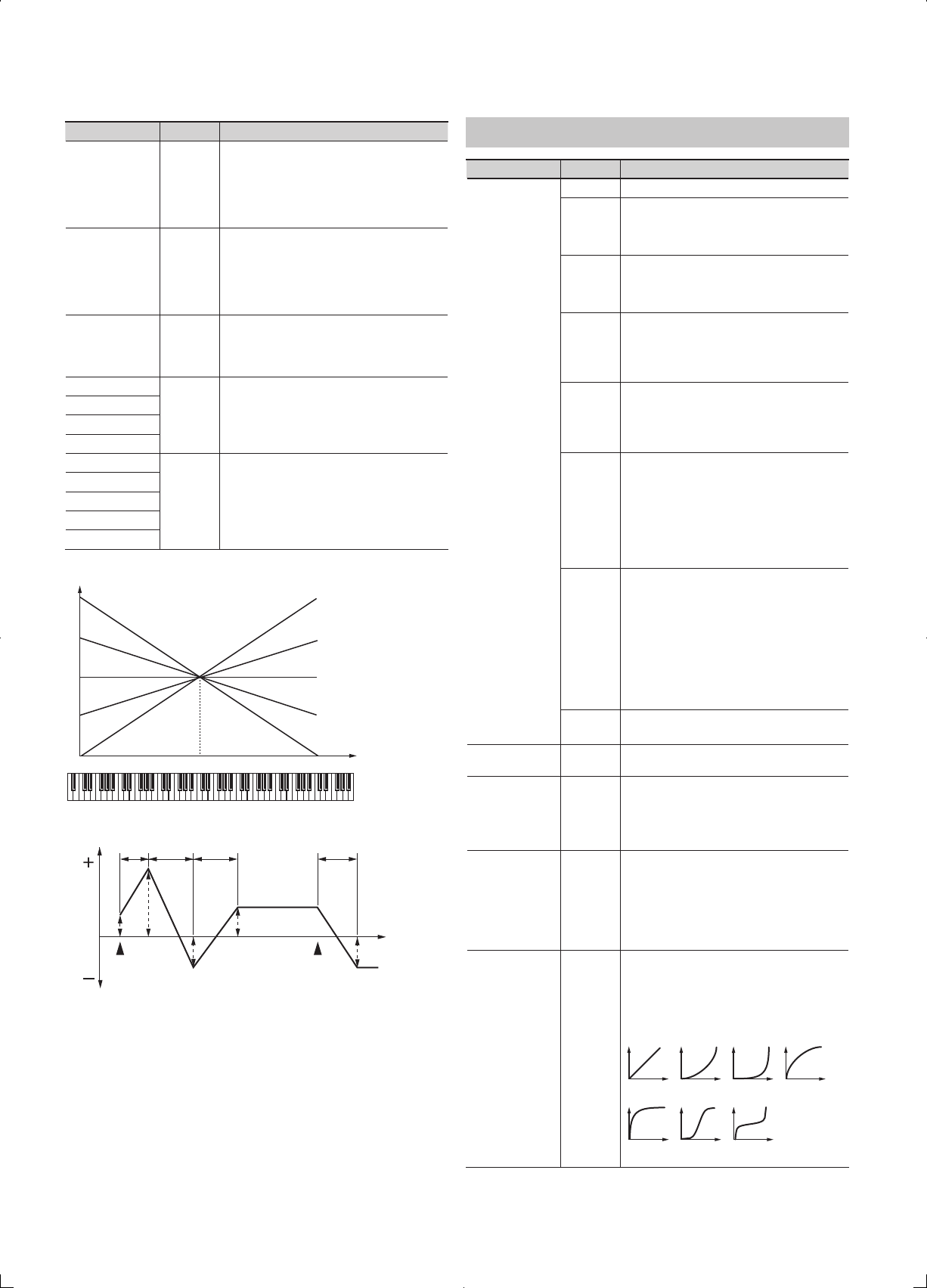
40
Parameter Value Explanation
P-Env T4 V-Sens -64–+63
Use this parameter when you want key release
speed to aect the T4 value of the Pitch
envelope.
If you want T4 to be speeded up for quickly
released notes, set this parameter to a positive
(+) value.
P-Env Time KF
(Time Keyfollow)
-64–+63
Use this setting if you want the pitch envelope
times (T2–T4) to be aected by the keyboard
location.
Based on the pitch envelope times for the C4
key, positive (+) settings will cause notes higher
than C4 to have increasingly shorter times.
P-Env Depth -12–+12
Depth of the Pitch envelope
Higher settings will cause the pitch envelope to
produce greater change. Negative (-) settings
will invert the shape of the envelope.
P-Env Time1 [A]
-64–+63
Pitch envelope times (T1–T4)
Higher settings will result in a longer time until
the next pitch is reached.
P-Env Time2
P-Env Time3 [D]
P-Env Time4 [R]
P-Env Level0
-64–+63
Pitch envelope levels (L0–L4)
Specify how the pitch will change at each point,
relative to the pitch set with Coarse Tune or Fine
Tune.
P-Env Level1
P-Env Level2
P-Env Level3 [S]
P-Env Level4
C4C3C2C1 C5 C6 C7
0
+50
+100
-50
-100
Time Keyfollow
Time
Key
T1 T2 T3 T4
L3
L4
L2
L1
L0
Pitch Envelope
Time
Note oNote on
Pitch
3. TVF PARAMETER
Parameter Value Explanation
Filter Type
OFF No lter is used.
LPF
Low Pass Filter.
This reduces the volume of all frequencies above
the Cuto Frequency in order to round o, or
un-brighten the sound.
BPF
Band Pass Filter.
This leaves only the frequencies in the region of
the Cuto Frequency, and cuts the rest. This can
be useful when creating distinctive sounds.
HPF
High Pass Filter.
This cuts the frequencies in the region below
the Cuto Frequency. This is suitable for creating
percussive sounds emphasizing their higher
tones.
PKG
Peaking Filter.
This emphasizes the frequencies in the region of
the Cuto Frequency. You can use this to create
wah-wah eects by employing an LFO to change
the Cuto Frequency cyclically.
LPF2
Low Pass Filter 2.
Although frequency components above the
Cuto Frequency are cut, the sensitivity of this
lter is half that of the LPF. This lter is good for
use with simulated instrument sounds such as
the acoustic piano.
* If you set “LPF2” the setting for the
Resonance parameter will be ignored.
LPF3
Low Pass Filter 3.
Although frequency components above the
Cuto Frequency are cut, the sensitivity of
this lter changes according to the Cuto
Frequency. While this lter is also good for use
with simulated acoustic instrument sounds, the
nuance it exhibits diers from that of the LPF2,
even with the same TVF Envelope settings.
* If you set “LPF3,” the setting for the
Resonance parameter will be ignored.
TONE
The setting of the tone assigned to the layer will
be used.
Cuto Frequency -63–+63
Frequency at which the lter begins to have an
eect on the waveform’s frequency components
Resonance -64–+63
Emphasizes the portion of the sound in the
region of the cuto frequency, adding character
to the sound
Excessively high settings can produce oscillation,
causing the sound to distort.
Cuto Keyfollow -200–+200
Use this parameter if you want the cuto
frequency to change according to the key that
is pressed
Relative to the cuto frequency at the C4 key
(center C), positive (+) settings will cause the
cuto frequency to rise for notes higher than C4.
Larger settings will produce greater change.
Cuto V-Curve
FIX,
1–7, TONE
Curve that determines how keyboard
playing dynamics (velocity) will aect the cuto
frequency
Set this to “FIX” if you don’t want the Cuto
frequency to be aected by the keyboard
velocity.
1 2 3 4
5 6 7
1 2 3 4
5 6 7


















